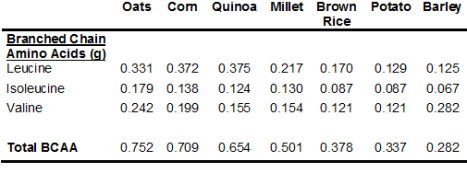Listed below are total protein, essential amino acids, branched chain amino acids, and arginine content for quinoa, oats, corn, millet, barley, brown rice and potato. The values provided are for 100 calories, for each respective grain.
Let’s ask some questions:
1. Is there a difference in protein content among these 7 grains?
Yes, there is a difference. Per 100 calories, oats are king, containing more than 2x the amount of protein in barley, the lowest ranking grain on this list. In fact, oats, quinoa and corn each have approximately 2x more total protein than each of the lowest ranking grains, potato, brown rice and barley. Millet is intermediate, at 2.95 grams of protein per 100 calories.

2. Can these grains be considered as “complete protein”?
A “complete protein” is defined as containing all of the 10 essential amino acids (EAA). As shown in the table below, each of the 7 grains contains all of the 10 essential amino acids. Oats contain the greatest amount of essential amino acids (Total EAA), followed by corn and quinoa.

3. Which grain contains the highest amount of branched chain amino acids (leucine, isoleucine and valine)?
The branched chain amino acids (BCAA) leucine, isoleucine and valine are well documented to stimulate muscle protein synthesis (Blomstrand et al. 2006). Oats, corn and millet contain the highest amounts of total BCAA, followed by quinoa, brown rice, potato and barley.

4. Which grain is highest in arginine?
Arginine is the required precursor for the production of nitric oxide (NO), which has been claimed to promote vasodilation in active muscle during exercise, thereby improving strength, power and recovery (Alvares et al. 2011). As shown in the table below, once again, oats contain the highest amount of arginine, followed by quinoa and brown rice.

Conclusions:
1) Oats contain the highest amount of total protein, relative to the other grains on this list.
2) All of the 7 grains on this list contain milligram amount of all of the 10 essential amino acids, making each of them a complete protein. Oats contain the highest total amount of essential amino acids, relative to the other grains on this list.
3) Oats also contain the highest amount of branched chain amino acids and arginine, when compared with all the other grains on this list.
If you’re interested, please have a look at my book!
References:
Álvares TS, Meirelles CM, Bhambhani YN, Paschoalin VM, Gomes PS. L-Arginine as a potential ergogenic aid in healthy subjects. Sports Med. 2011 Mar 1;41(3):233-48.
Blomstrand E, Eliasson J, Karlsson HK,Köhnke R. Branched-chain amino acids activate key enzymes in protein synthesis after physical exercise. J Nutr. 2006 Jan;136(1 Suppl):269S-73S.
Nutritional data provided by http://www.nal.usda.gov/fnic/foodcomp/search/






